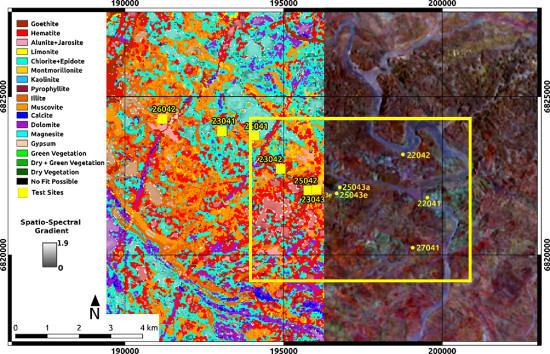EnGeoMAP 2.0—Automated Hyperspectral Mineral Identification for the German EnMAP Space Mission
Abstract
:1. Introduction
- The fully automated retrieval of characteristic absorption features from reference library spectra and unknown imaging spectroscopy data using the geometric hull approach [14].
- The explicit incorporation of extended sensor parameters (e.g., the sensors Point Spread Function (PSF), spectral Signal to Noise Ratio (SNR) and the related image SNR.
- The calculation of spatio-spectral gradients.
- The automated extraction of mineral anomalies (hydrothermal alteration zones and gossan zones) according to geologic expert knowledge.
2. Study Sites
2.1. The Rodalquilar Mineral Deposits
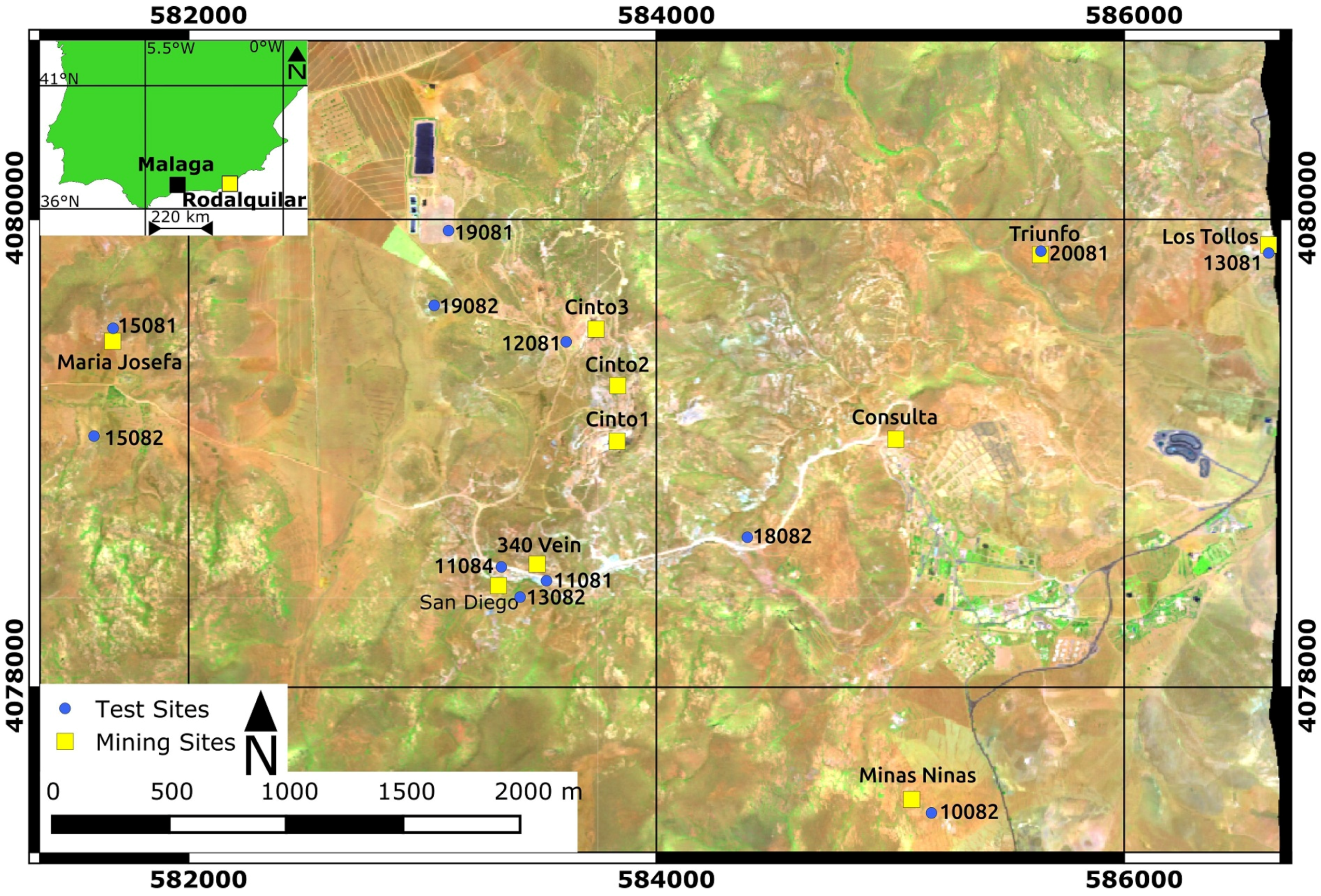
2.2. The Haib River Porphyry Copper-Molybdenum Deposit
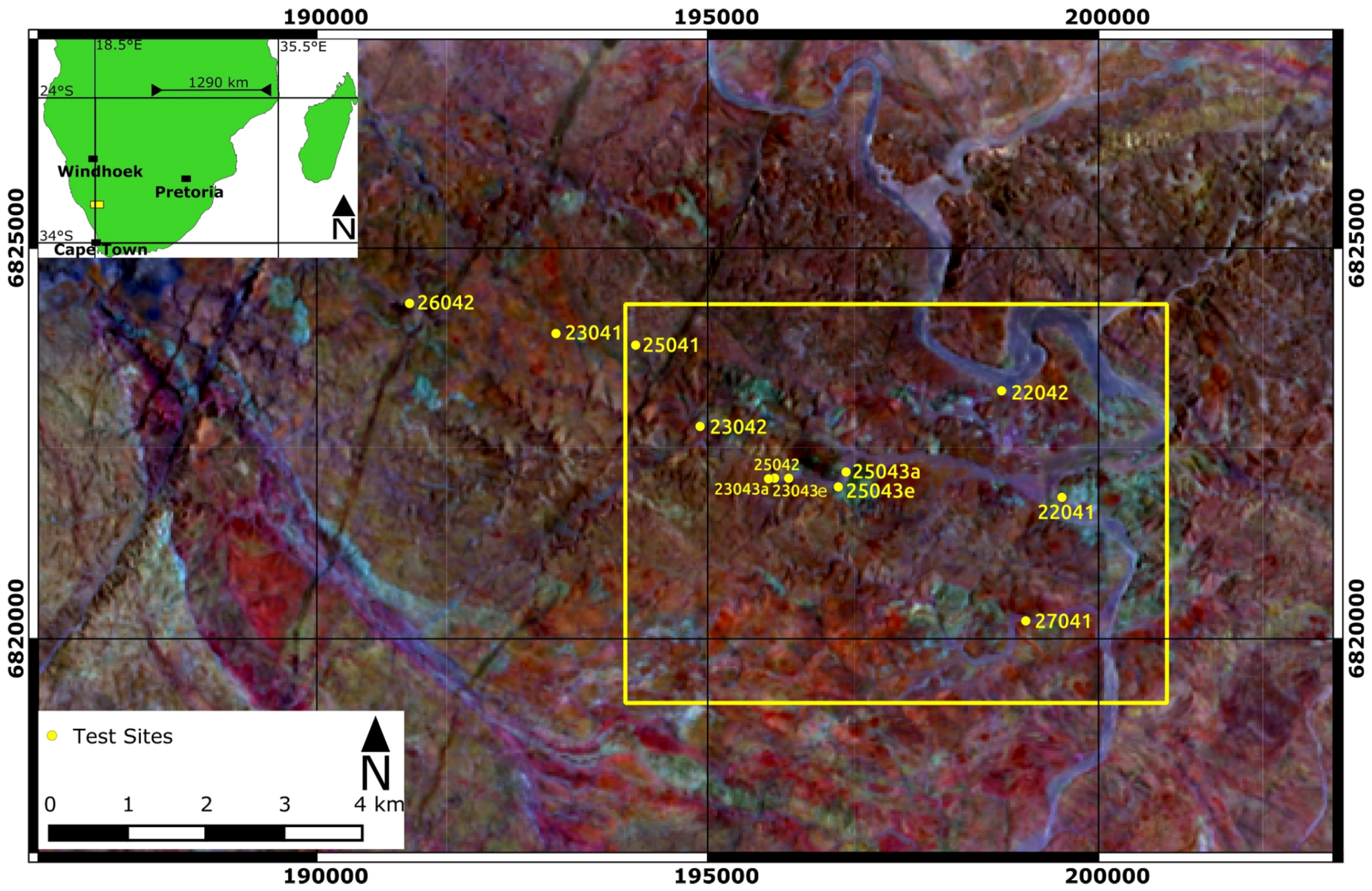
3. Fieldwork and Preprocessing
3.1. Fieldwork
3.2. Data Preprocessing
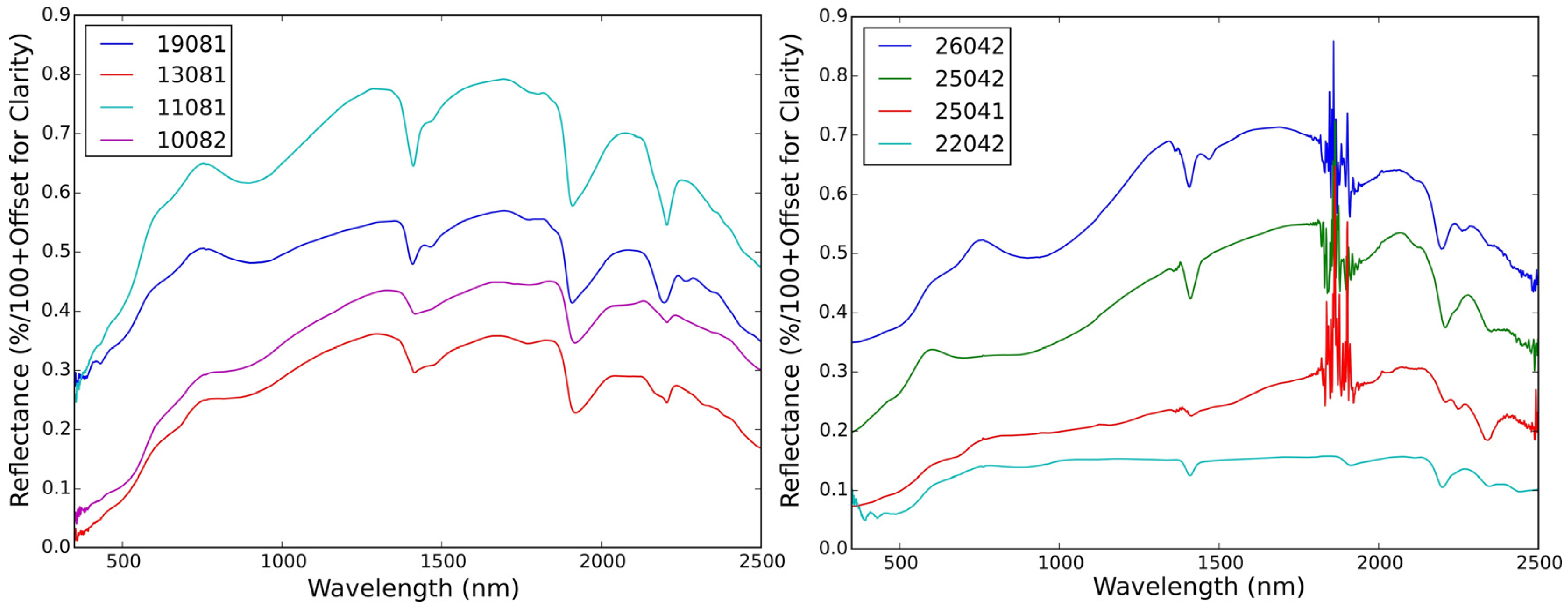
4. The EnGeoMAP 2.0 Process
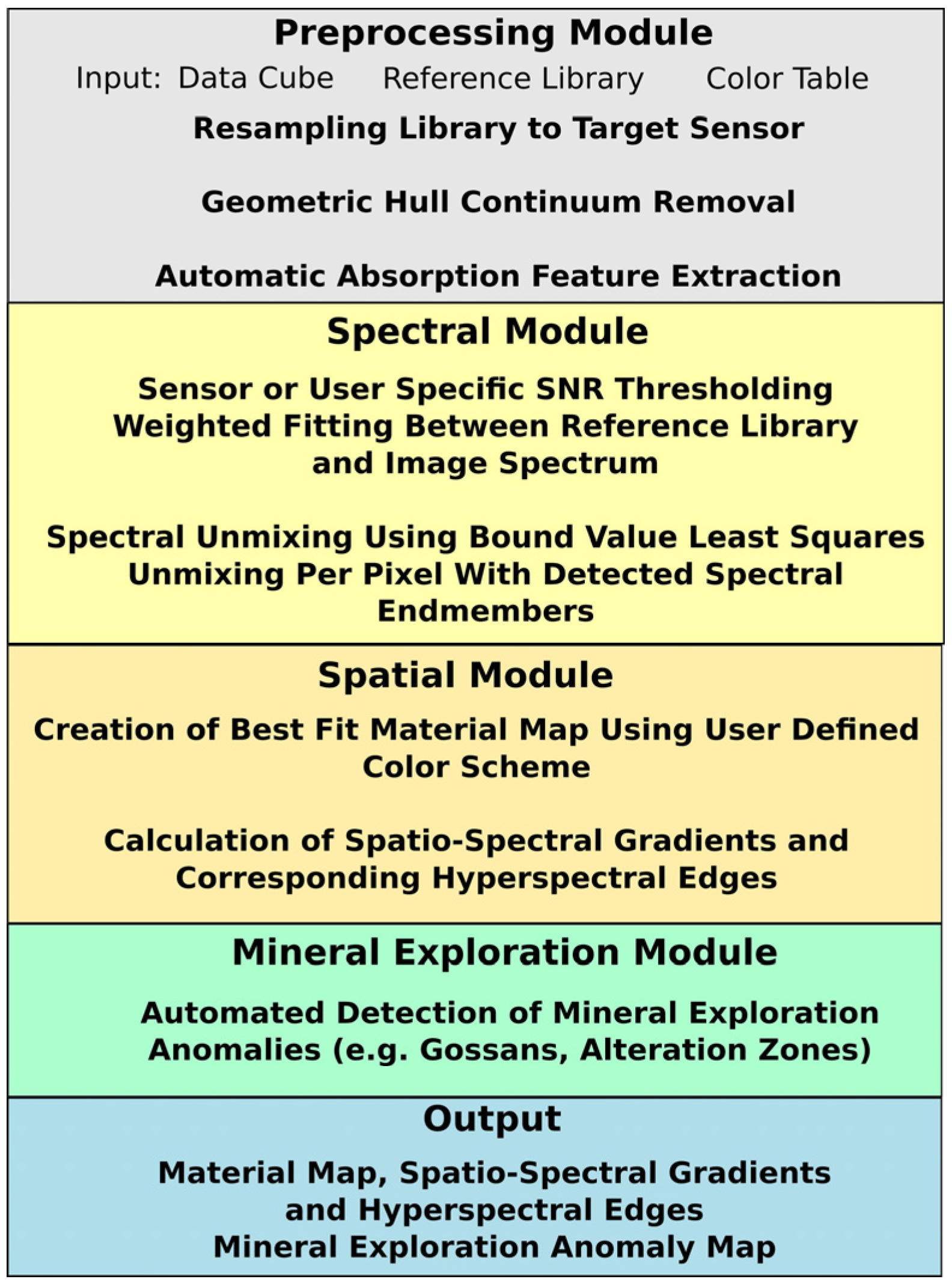
4.1. Automated Identification of Characteristic Absorption Bands
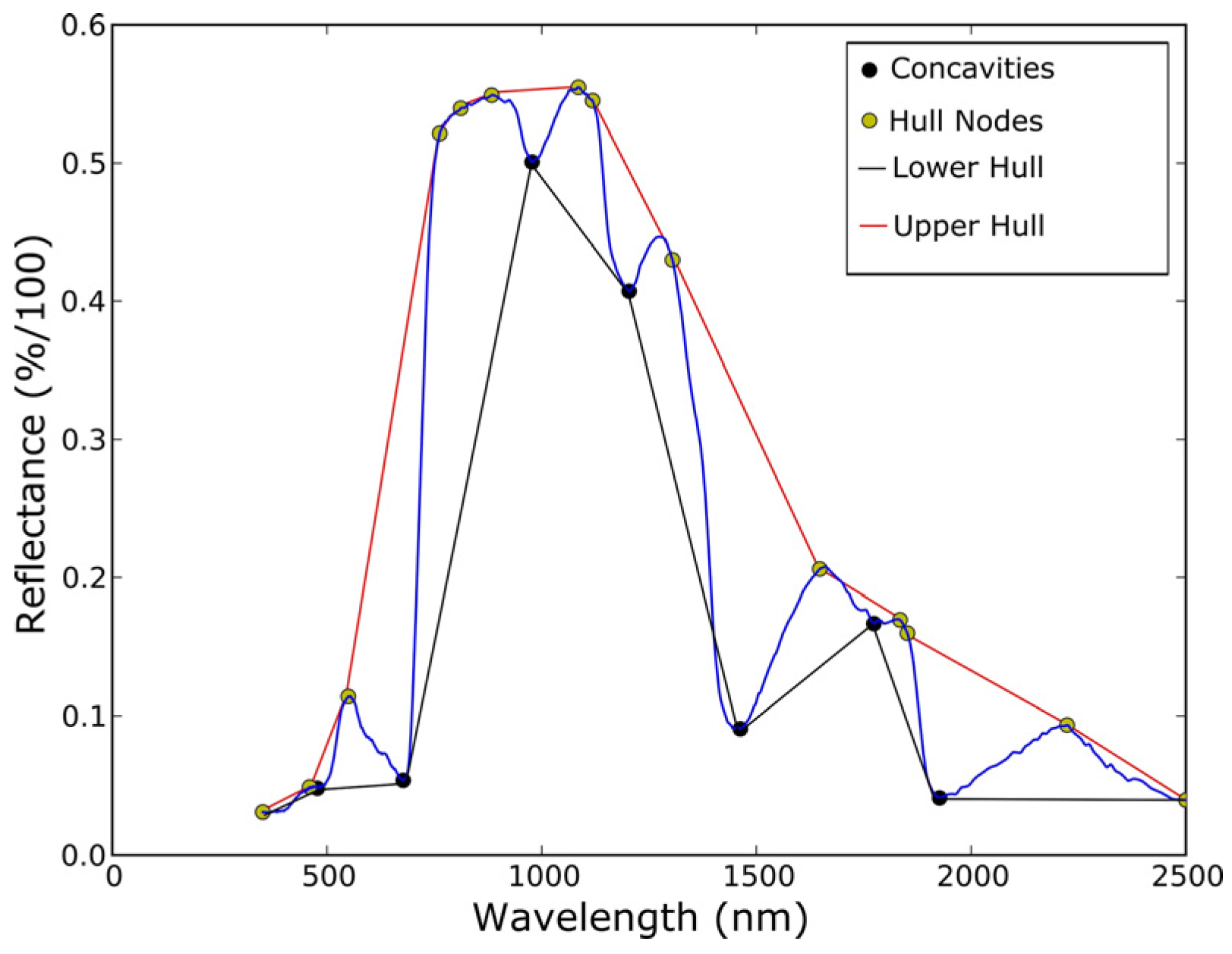
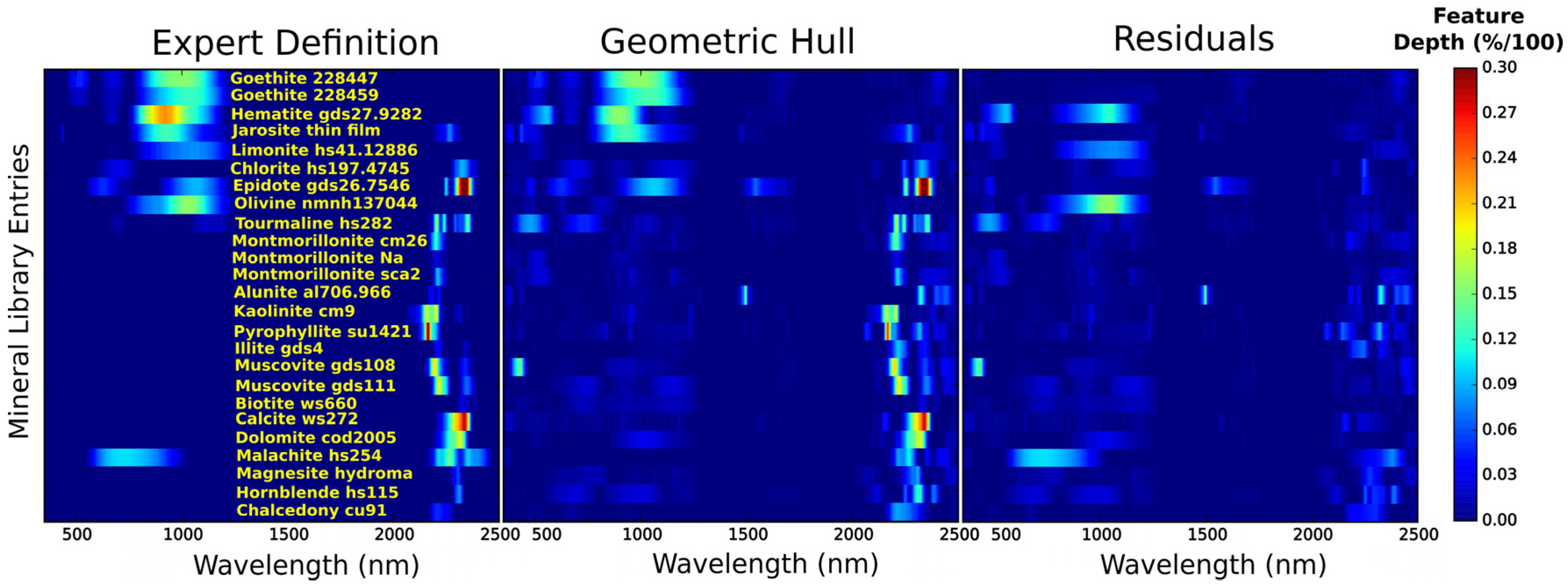
4.2. Continuum Removal for Absorption Band Retrieval
4.3. User Independent SNR Thresholding
4.4. Weighted Fitting
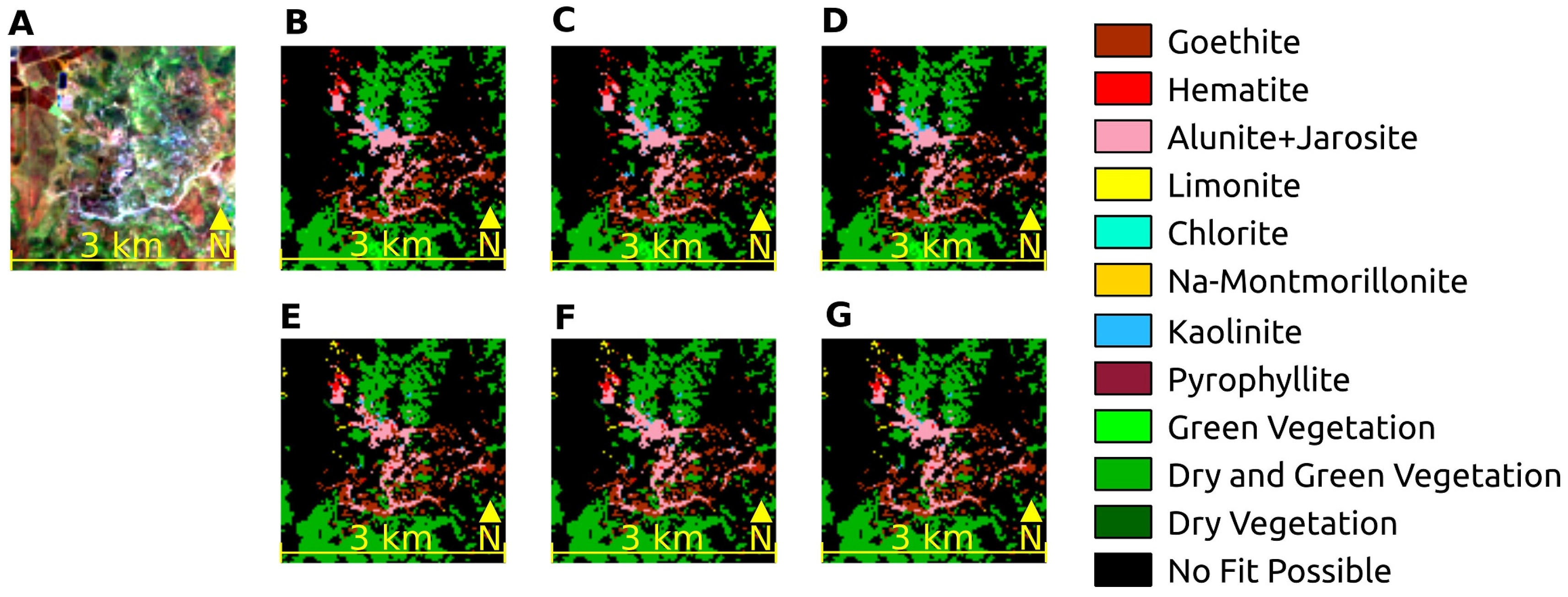
| Method | Runtime (s) | MSSIM with Linear Regression | Algorithm Complexity | Overall Performance |
|---|---|---|---|---|
| Linear Correlation | 61.44 | 1.0 | 1 | A |
| Linear Regression | 92.38 | 1.0 | 2 | B |
| MSAM | 130.04 | 1.0 | 2 | C |
| SID | 131.67 | 0.889 | 2 | D |
| SIDx(SIN(MSAM)) | 206.29 | 0.89 | 3 | E |
| SIDx(TAN(MSAM)) | 300.77 | 0.89 | 3 | F |
4.5. Calculation of Spatio-Spectral Gradients
4.6. Automated Retrieval of Potential Exploration Anomalies
5. Results of EnGeoMAP 2.0
5.1. Results from the Rodalquilar Deposits Using the GFZ Spectral Library
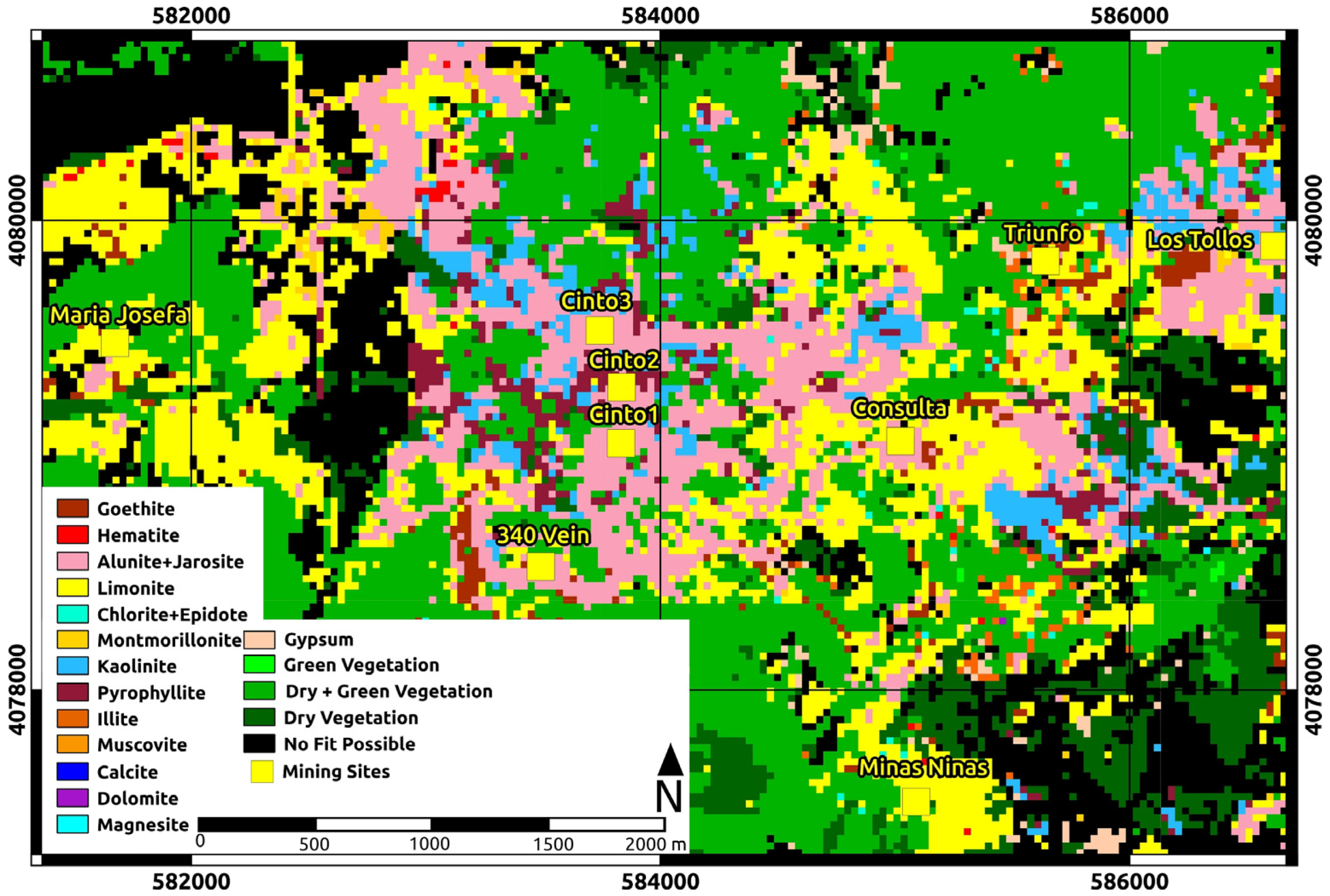

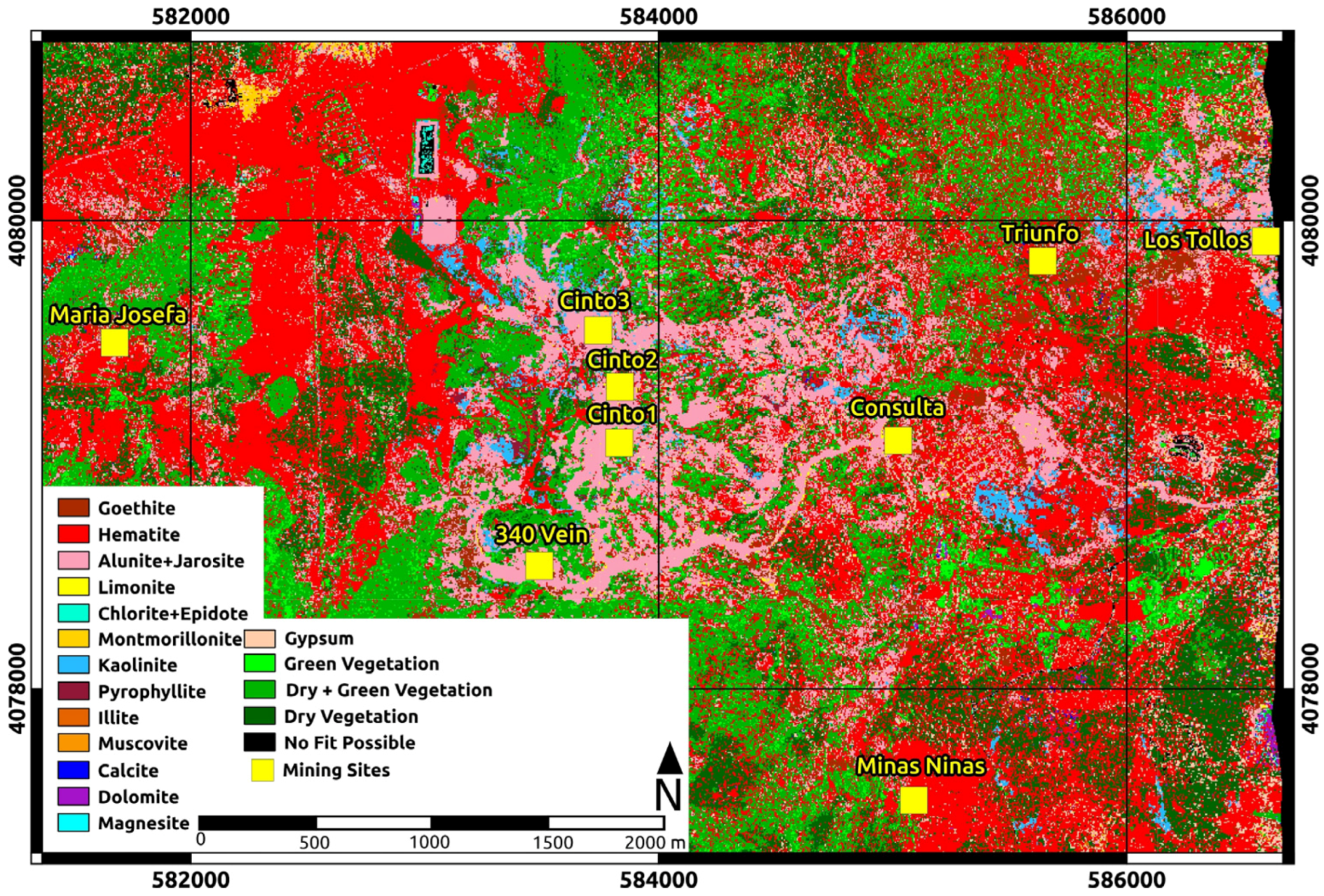
5.2. Results from the Rodalquilar Deposits Using the USGS Digital Spectral Library
5.3. Results from the Haib River Deposit Using the GFZ Spectral Library


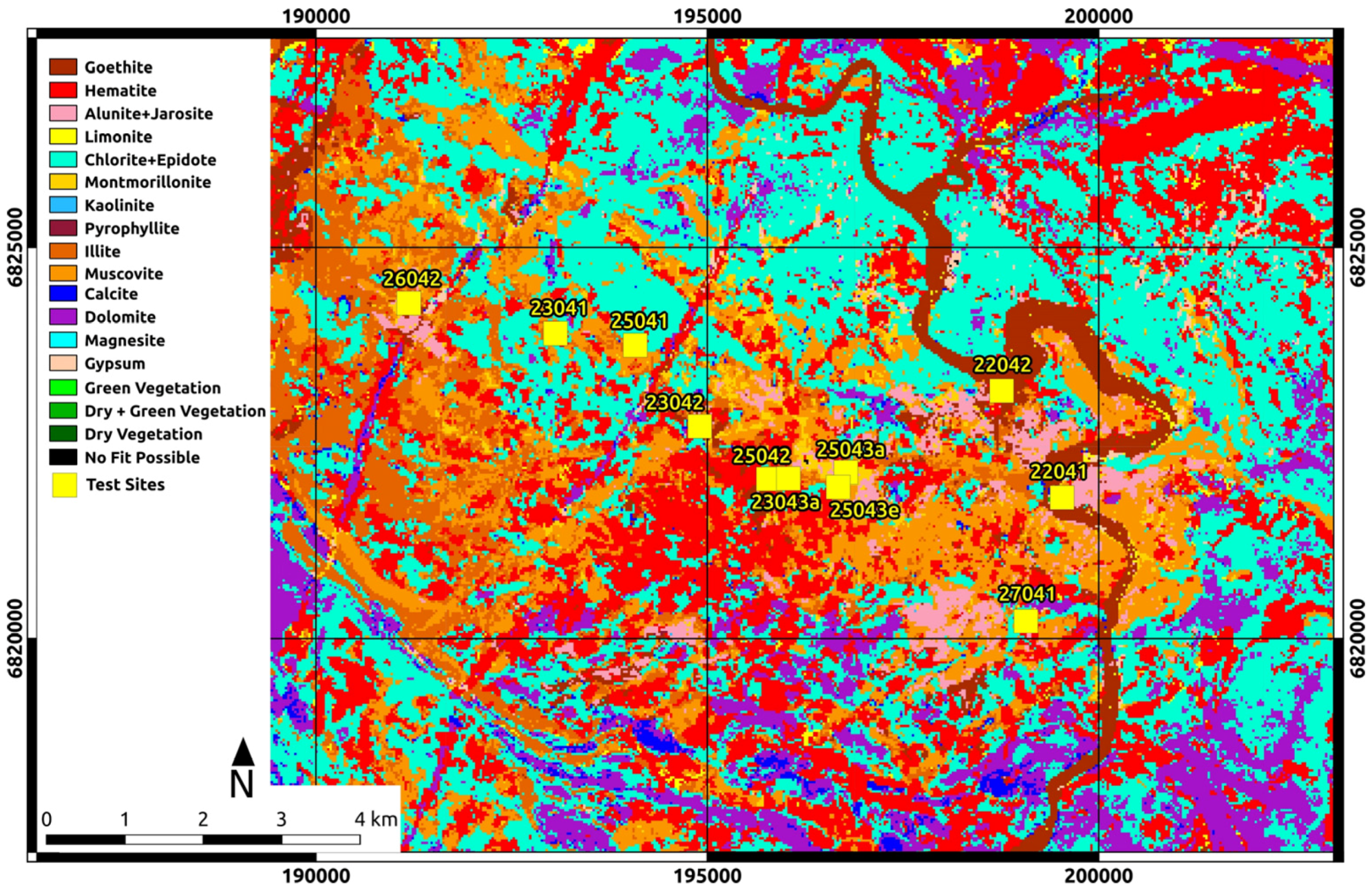
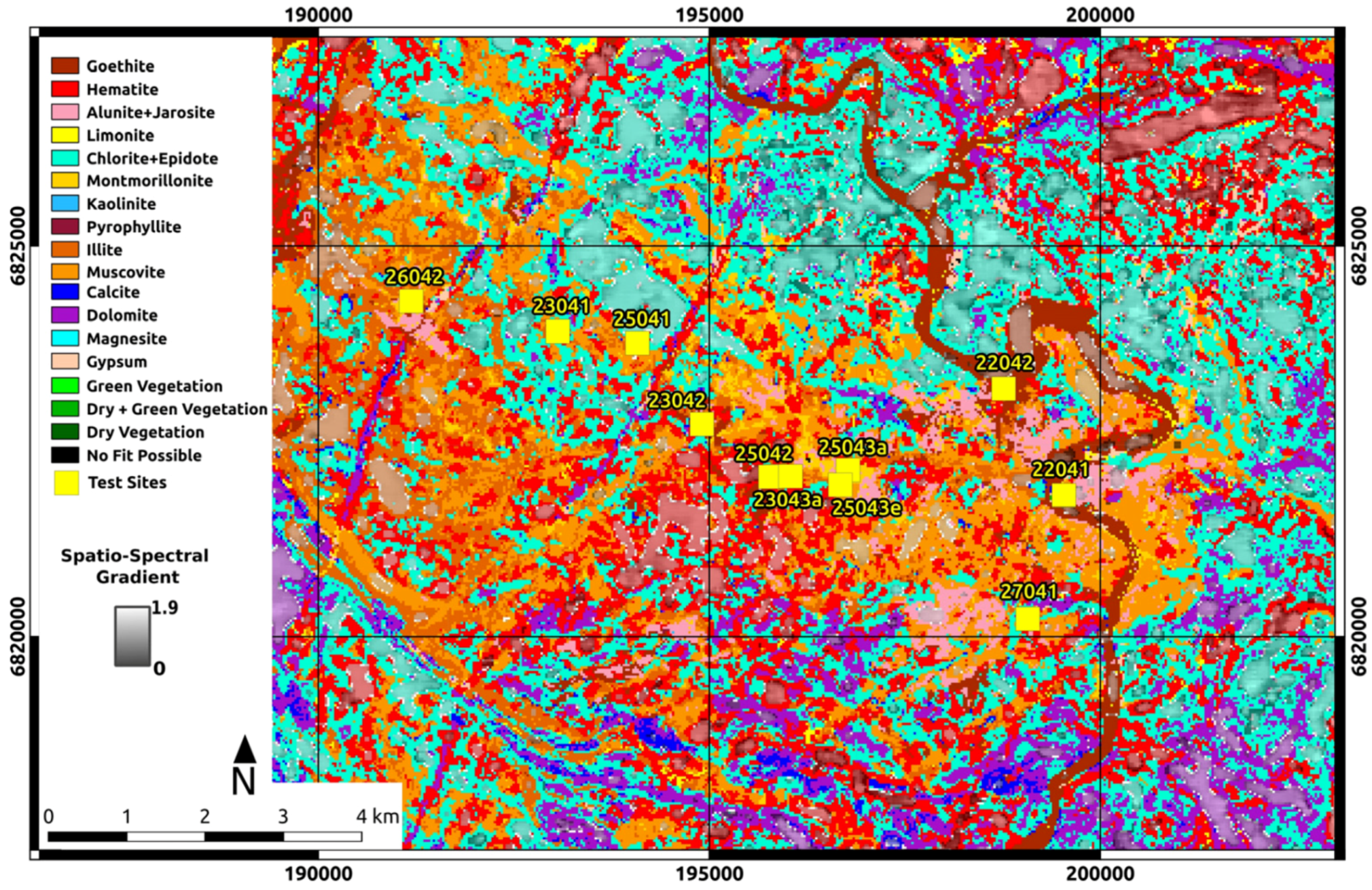
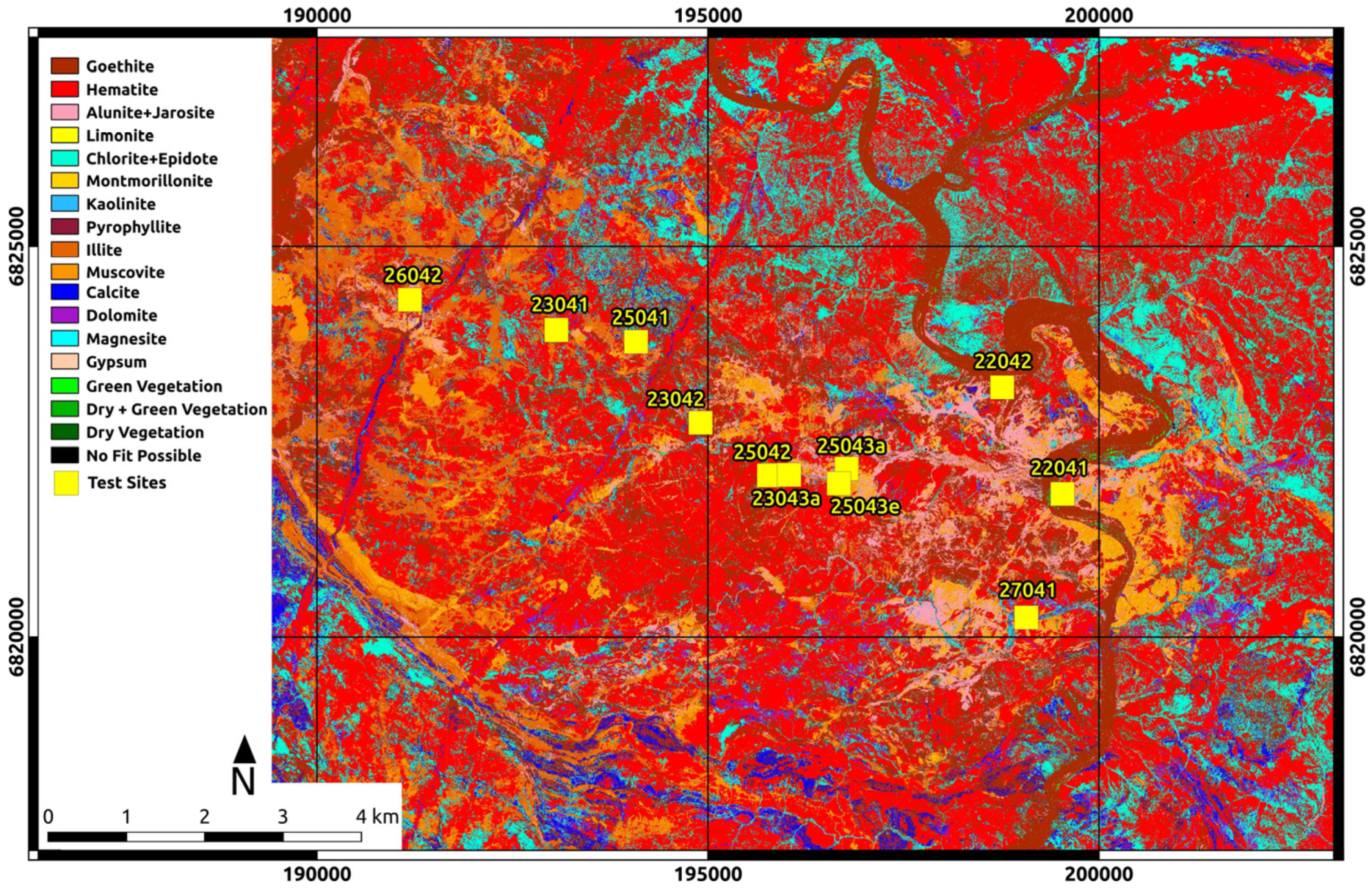
5.4. Results from the Haib River Deposit Using the USGS Digital Spectral Library
5.5. Automated Delineation of Exploration Anomalies
5.5.1. Rodalquilar
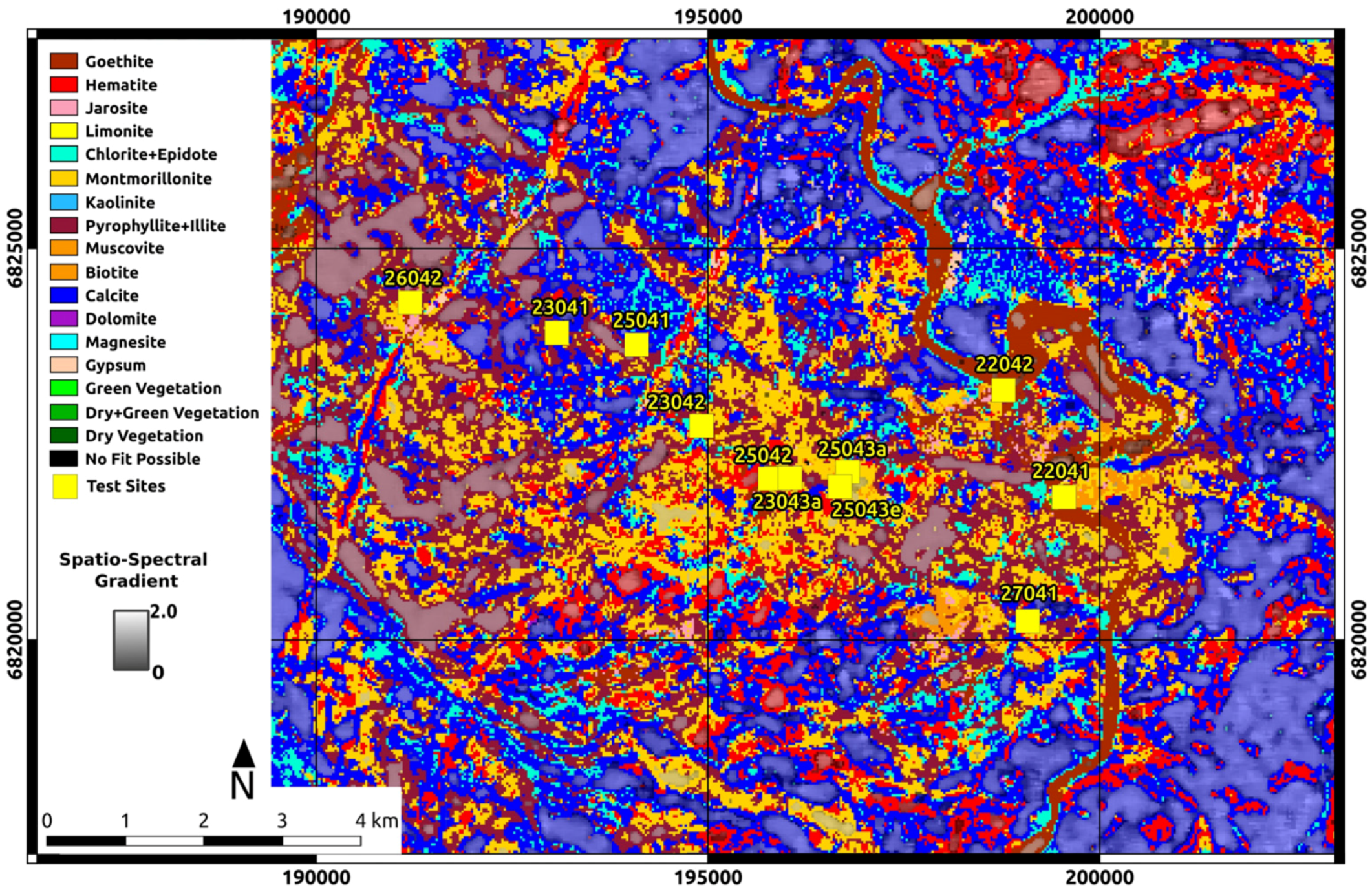
5.5.2. Haib River
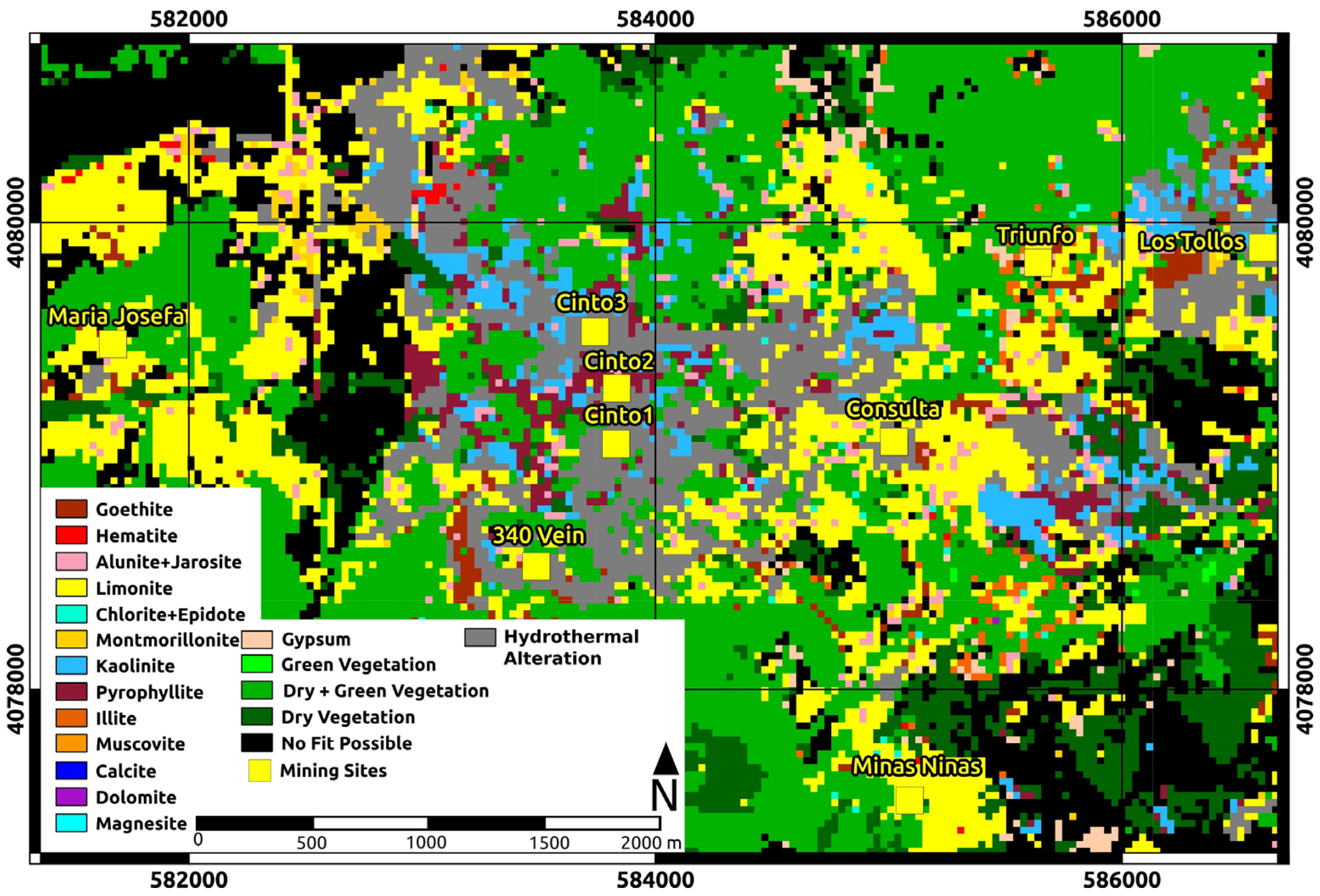
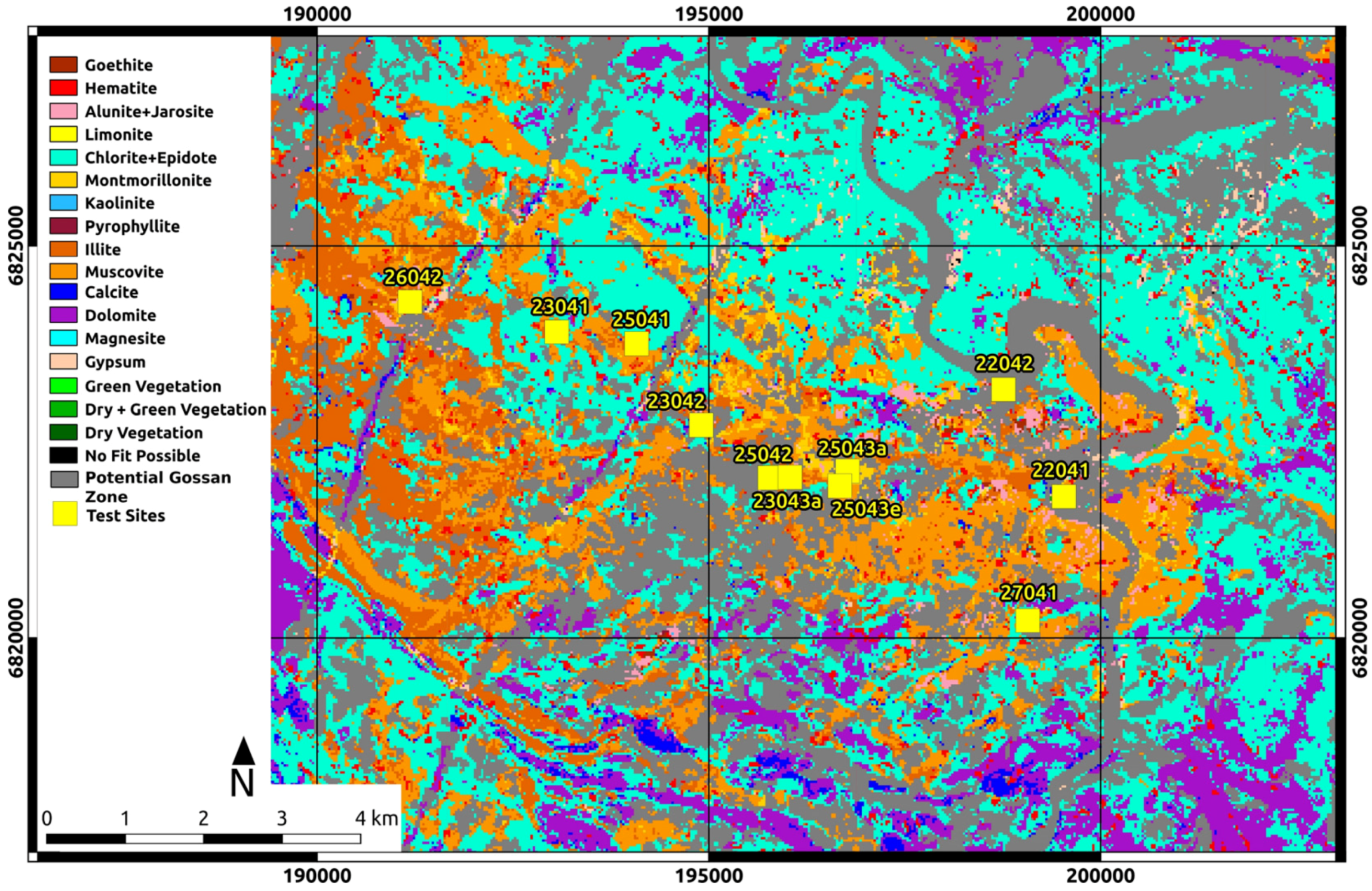
6. Performance of EnGeoMAP 2.0 for EnMAP Data

7. Validation

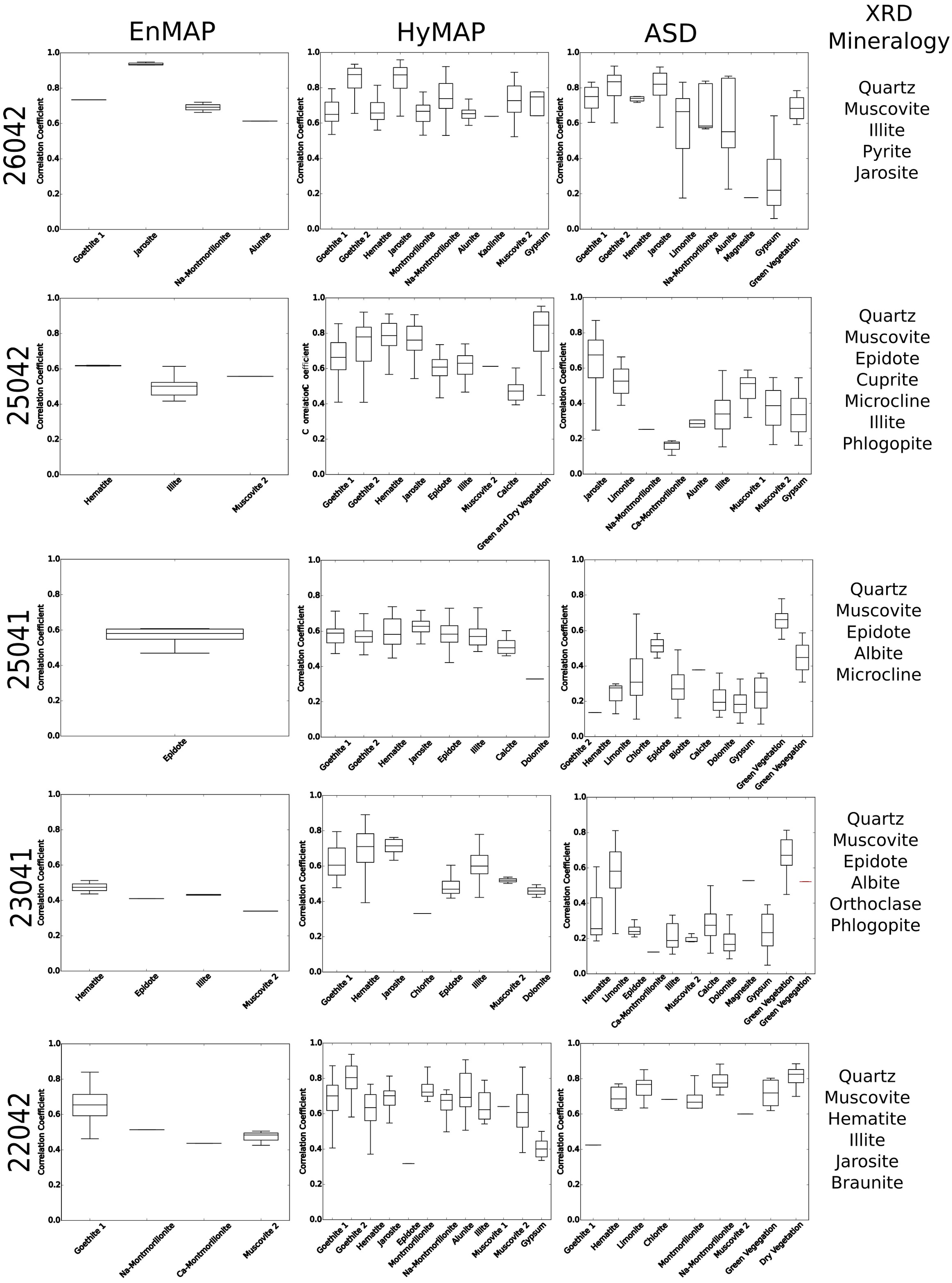
8. Conclusions and Outlook
- It is able to produce material maps using the geometric hull automated absorption feature definition, which requires no a priori knowledge about the shape of the reference library spectra or the image spectra [14]. This is different to the fixed defined features of part of the USGS Tetracorder or MICA [9,10].
- The EnGeoMAP 2.0 algorithm is able to incorporate sensor specific SNR information. Otherwise user defined minimum absorption depths for VNIR and SWIR absorption features may be used.
- The calculation of spatio-spectral gradients of e.g., EnMAP data is possible by hyperspectral gradient detection [32]. It may be used to outline areas of high spatial material heterogeneity. These areas may otherwise only be resolved by calculating material maps from cost intensive hyperspectral airborne image scenes.
Supplementary Materials
Acknowledgments
Author Contributions
Conflicts of Interest
Appendix A
| Location | Scene ID |
|---|---|
| Rodalquilar (Spain) | EO1H1990342003037110PZ |
| Rodalquilar (Spain) | EO1H1990342003060110KZ |
| Haib (Namibia) | EO1H1760802013267110KF |
| Haib (Namibia) | EO1H1760802014013110PF |
| Haib (Namibia) | EO1H1760802014066110K2 |
| Haib (Namibia) | EO1H1760802014347110KF |
References
- Middleton, E.M.; Ungar, S.G.; Mandl, D.J.; Ong, L.; Frye, S.W.; Campbell, P.E.; Landis, D.R.; Young, J.P.; Pollack, N.H. The earth observing one (EO-1) satellite mission: Over a decade in space. IEEE J. Sel. Top. Appl. Earth Obs. Remote Sens. 2013, 6, 243–256. [Google Scholar] [CrossRef]
- Cocks, T.; Jenssen, R.; Stewart, A.; Wilson, I.; Shields, T. The HyMapTM airborne hyperspectral sensor: The system, calibration and performance. In Proceedings of the 1st EARSeL Workshop on Imaging Spectroscopy, Zurich, Switzerland, 6–8 October 1998; pp. 37–42.
- Baarstad, I.; Løke, T.; Kaspersen, P. ASI–A new airborne hyperspectral imager. In Proceedings of the 4th EARSeL Workshop on Imaging Spectroscopy, Warsaw, Poland, 27–29 April 2005; pp. 107–110.
- Mielke, C.; Rogass, C.; Boesche, N.K.; Segl, K.; Kaufmann, H. Multi- and hyperspectral satellite sensors for mineral exploration, new applications to the Sentinel-2 and EnMAP mission. In Proceedings of the EARSeL 34th Symposium Proceedings, Warsaw, Poland, 16–20 June 2014. [CrossRef]
- Kopačková, V. Using multiple spectral feature analysis for quantitative pH mapping in a mining environment. Int. J. Appl. Earth Obs. Geoinform. 2014, 28, 28–42. [Google Scholar] [CrossRef]
- Swayze, G.A.; Smith, K.S.; Clark, R.N.; Sutley, S.J.; Pearson, R.M.; Vance, J.S.; Hageman, P.L.; Briggs, P.H.; Meier, A.L.; Singleton, M.J.; et al. Using imaging spectroscopy to map acidic mine waste. Environ. Sci. Technol. 2000, 34, 47–54. [Google Scholar] [CrossRef]
- Guanter, L.; Kaufmann, H.; Segl, K.; Foerster, S.; Rogass, C.; Chabrillat, S.; Kuester, T.; Hollstein, A.; Rossner, G.; Chlebek, C.; et al. The EnMAP spaceborne imaging spectroscopy mission for earth observation. Remote Sens. 2015, 7, 8830–8857. [Google Scholar] [CrossRef]
- Iwasaki, A.; Ohgi, N.; Tanii, J.; Kawashima, T.; Inada, H. Hyperspectral Imager Suite (HISUI)—Japanese hyper-multi spectral radiometer. In Proceedings of the 2011 IEEE International Geoscience and Remote Sensing Symposium (IGARSS), Vancouver, BC, Canada, 24–29 July 2011; pp. 1025–1028.
- Clark, R.N.; Swayze, G.A.; Livo, K.E.; Kokaly, R.F.; Sutley, S.J.; Dalton, J.B.; McDougal, R.R.; Gent, C.A. Imaging spectroscopy: Earth and planetary remote sensing with the USGS Tetracorder and expert systems. J. Geophys. Res. Planets 2003, 108. [Google Scholar] [CrossRef]
- Kokaly, R.F. Spectroscopic remote sensing for material identification, vegetation characterization, and mapping. Proc. SPIE 2012, 8390. [Google Scholar] [CrossRef]
- Kokaly, R.F.; King, T.V.V.; Livo, K.E. Airborne Hyperspectral. Survey of Afghanistan 2007: Flight Line Planning and HyMAP Data Collection; Open File Report; United States Geological Survey: Reston, VA, USA, 2008. [Google Scholar]
- Clark, R.N.; Swayze, G.A.; Wise, R.; Livo, E.; Hoefen, T.M.; Kokaly, R.F.; Sutley, S.J. USGS Digital Spectral Library Splib06a; Geological Survey Data Series 231; U.S. Geological Survey: Denver, CO, USA, 2007.
- Rogass, C.; Segl, K.; Mielke, C.; Fuchs, Y. EnGeoMAP—A geological mapping tool applied to the EnMAP mission. EARSeL EProc. 2013, 12, 94–100. [Google Scholar]
- Mielke, C.; Boesche, N.K.; Rogass, C.; Kaufmann, H.; Gauert, C. New geometric hull continuum removal algorithm for automatic absorption band detection from spectroscopic data. Remote Sens. Lett. 2015, 6, 97–105. [Google Scholar] [CrossRef]
- Segl, K.; Guanter, L.; Rogass, C.; Kuester, T.; Roessner, S.; Kaufmann, H.; Sang, B.; Mogulsky, V.; Hofer, S. EeteS the EnMAP end-to-end simulation tool. IEEE J. Sel. Top. Appl. Earth Obs. Remote Sens. 2012, 5, 522–530. [Google Scholar] [CrossRef]
- Arribas, A.; Cunningham, C.G.; Rytuba, J.J.; Rye, R.O.; Kelly, W.C.; Podwysocki, M.H.; McKee, E.H.; Tosdal, R.M. Geology, geochronology, fluid inclusions, and isotope geochemistry of the Rodalquilar gold alunite deposit, Spain. Econ. Geol. 1995, 90, 795–822. [Google Scholar] [CrossRef]
- Minnitt, R.C.A. Porphyrry Copper-Molybdenium Mineralization at Haib River, South West Africa/Namibia. In Mineral Deposits of Southern Africa; Anhaeusser, C.R., Maske, S., Eds.; Geological Society of South Africa: Johannesburg, South Africa, 1986; Volume 2, pp. 1567–1585. [Google Scholar]
- Rogass, C.; Mielke, C.; Scheffler, D.; Boesche, N.K.; Lausch, A.; Lubitz, C.; Brell, M.; Spengler, D.; Eisele, A.; Segl, K.; et al. Reduction of uncorrelated striping noise—Applications for hyperspectral pushbroom acquisitions. Remote Sens. 2014, 6, 11082–11106. [Google Scholar] [CrossRef]
- Pearlman, J.S. Hyperion Validation Report; Boeing Report; Phantom Works, The Boeing Company: Kent, WA, USA, 2003. [Google Scholar]
- Van der Meer, F.D.; van der Werff, H.; van Ruitenbeek, F.J.A.; Hecker, C.A.; Bakker, W.H.; Noomen, M.F.; van der Meijde, M.; Carranza, E.J.M.; Smeth, J.; Woldai, T. Multi-and hyperspectral geologic remote sensing: A review. Int. J. Appl. Earth Obs. Geoinform. 2012, 14, 112–128. [Google Scholar] [CrossRef]
- Arribas, A., Jr.; Rytuba, J.J.; Rye, R.O.; Cunningham, C.G.; Podwysocki, M.H.; Kelly, W.C.; Arribas, A.S.; McKee, E.H.; Smith, J.G. Preliminary Study of the Ore Deposits and Hydrothermal Alteration in the Rpdalquilar. Caldera Complex, Southeastern Spain; USGS Open-File Report; United States Geological Survey: Reston, VA, USA, 1989.
- Rytuba, J.J.; Arribas, A.A.; Cunningham, C.G.; McKee, E.H.; Podwysocki, M.H.; Smith, J.G.; Kelly, W.C.; Arribas, A. Mineralized and unmineralized calderas in Spain; Part II, evolution of the Rodalquilar caldera complex and associated gold-alunite deposits. Miner. Depos. 1990, 25, S29–S35. [Google Scholar] [CrossRef]
- Cunningham, C.G.; Arribas, A.; Rytuba, J.J. Mineralized and unmineralized calderas in Spain; Part I, evolution of the Los Frailes Caldera. Miner. Depos. 1990, 25, S21–S28. [Google Scholar] [CrossRef]
- Pirajno, F. Hydrothermal Processes and Mineral Systems; Springer-Verlag: Berlin, Germany, 2009. [Google Scholar]
- Barr, J.M.; Reid, D.L. Hydrothermal alteration at the Haib porphyry copper deposit, Namibia: Stable isotope and fluid inclusion patterns. Communs. Geol. Surv. Namib. 1993, 8, 23–34. [Google Scholar]
- Schläpfer, D.; Richter, R. Geo-atmospheric processing of airborne imaging spectrometry data. Part 1: Parametric orthorectification. Int. J. Remote Sens. 2002, 23, 2609–2630. [Google Scholar] [CrossRef]
- Richter, R.; Schläpfer, D. Geo-atmospheric processing of airborne imaging spectrometry data. Part 2: Atmospheric/topographic correction. Int. J. Remote Sens. 2002, 23, 2631–2649. [Google Scholar] [CrossRef]
- Rogass, C.; Guanter, L.; Mielke, C.; Scheffler, D.; Boesche, N.K.; Lubitz, C.; Brell, M.; Spengler, D.; Segl, K. An automated processing chain for the retrieval of georeferenced reflectance data from hyperspectral EO-1 Hyperion acquisitions. In Proceedings of the EARSeL 34th Symposium Proceedings, Warsaw, Poland, 16–20 June 2014. [CrossRef]
- Van der Linden, S.; Rabe, A.; Held, M.; Jakimow, B.; Leitão, P.; Okujeni, A.; Schwieder, M.; Suess, S.; Hostert, P. The EnMAP-Box—A toolbox and application programming interface for EnMAP data processing. Remote Sens. 2015, 7, 11249–11266. [Google Scholar] [CrossRef]
- Storch, T.; De Miguel, A.; Müller, R.; Müller, A.; Neumann, A.; Walzel, T.; Bachmann, M.; Palubinskas, G.; Lehner, M.; Richter, R.; et al. The future spaceborne hyperspectral imager EnMAP: Its calibration, validation, and processing chain. In Proceedings of the 21st Congress International Society for Photogrammetry and Remote Sensing, Beijing, China, 3–11 July 2008; pp. 1265–1270.
- Bakker, W.H.; Schmidt, K.S. Hyperspectral edge filtering for measuring homogeneity of surface cover types. ISPRS J. Photogramm. Remote Sens. 2002, 56, 246–256. [Google Scholar] [CrossRef]
- Rogaß, C.; Itzerott, S.; Schneider, B.U.; Kaufmann, H.; Hüttl, R.F. Hyperspectral boundary detection based on the busyness multiple correlation edge detector and alternating vector field convolution snakes. ISPRS J. Photogramm. Remote Sens. 2010, 65, 468–478. [Google Scholar] [CrossRef]
- Hunt, J.M.; Turner, D.S. Determination of mineral constituents of rocks by infrared spectroscopy. Anal. Chem. 1953, 25, 1169–1174. [Google Scholar] [CrossRef]
- Hunt, G.R.; Ashley, R.P. Spectra of altered rocks in the visible and near infrared. Econ. Geol. 1979, 74, 1613–1629. [Google Scholar] [CrossRef]
- Townsend, T.E. Discrimination of iron alteration minerals in visible and near-infrared reflectance data. J. Geophys. Res. Solid Earth 1987, 92, 1441–1454. [Google Scholar] [CrossRef]
- Papenfuß, A. Detection of Copper Deposits Based on a New Spectral Library Using Imaging Spectroscopy. Master’s Thesis, Universität Potsdam, Potsdam, Germany, 2015. [Google Scholar]
- Gao, L.; Du, Q.; Zhang, B.; Yang, W.; Wu, Y. A comparative study on linear regression-based noise estimation for hyperspectral imagery. IEEE J. Sel. Top. Appl. Earth Obs. Remote Sens. 2013, 6, 488–498. [Google Scholar] [CrossRef]
- Oshigami, S.; Yamaguchi, Y.; Uezato, T.; Momose, A.; Arvelyna, Y.; Kawakami, Y.; Yajima, T.; Miyatake, S.; Nguno, A. Mineralogical mapping of southern Namibia by application of continuum-removal MSAM method to the HyMap data. Int. J. Remote Sens. 2013, 34, 5282–5295. [Google Scholar] [CrossRef]
- Du, Y.; Chang, C.-I.; Ren, H.; Chang, C.-C.; Jensen, J.O.; D’Amico, F.M. New hyperspectral discrimination measure for spectral characterization. Opt. Eng. 2004, 43, 1777–1786. [Google Scholar]
- Wang, Z.; Bovik, A.C.; Sheikh, H.R.; Simoncelli, E.P. Image quality assessment: From error visibility to structural similarity. IEEE Trans. Image Process. 2004, 13, 600–612. [Google Scholar] [CrossRef] [PubMed]
- Van der Meer, F. The effectiveness of spectral similarity measures for the analysis of hyperspectral imagery. Int. J. Appl. Earth Obs. Geoinform. 2006, 8, 3–17. [Google Scholar] [CrossRef]
- Quintano, C.; Fernández-Manso, A.; Shimabukuro, Y.E.; Pereira, G. Spectral unmixing. Int. J. Remote Sens. 2012, 33, 5307–5340. [Google Scholar] [CrossRef]
- Canny, J. A Computational approach to edge detection. IEEE Trans. Pattern Anal. Mach. Intell. 1986, PAMI-8, 679–698. [Google Scholar] [CrossRef]
- Swayze, G.A.; Clark, R.N.; Goetz, A.F.H.; Livo, K.E.; Breit, G.N.; Kruse, F.A.; Sutley, S.J.; Snee, L.W.; Lowers, H.A.; Post, J.L.; et al. Mapping advanced argillic alteration at Cuprite, Nevada, using imaging spectroscopy. Econ. Geol. 2014, 109, 1179–1221. [Google Scholar] [CrossRef]
- King, T.V.V.; Berger, B.R.; Johnson, M.R. Characterization of Potential Mineralization in Afghanistan: Four Permissive Areas Identified Using Imaging Spectroscopy Data; USGS Open-File Report; United States Geological Survey: Reston, VA, USA, 2014.
- Chavez, W.X., Jr. Supergene oxidation of copper deposits: Zoning and distribution of copper oxide minerals. Soc. Econ. Geol. Newsl. 2000, 41, 9–21. [Google Scholar]
- Taylor, R. Gossans and Leached Cappings—Field Assessment, 1st ed.; Springer: Berlin, Germany, 2011. [Google Scholar]
- Haralick, R.M.; Sternberg, S.R.; Zhuang, X. Image analysis using mathematical morphology. IEEE Trans. Pattern Anal. Mach. Intell. 1987, PAMI-9, 532–550. [Google Scholar] [CrossRef]
- Bedini, E.; van der Meer, F.; van Ruitenbeek, F. Use of HyMap imaging spectrometer data to map mineralogy in the Rodalquilar caldera, southeast Spain. Int. J. Remote Sens. 2009, 30, 327–348. [Google Scholar] [CrossRef]
- Richter, N. Pedogenic Iron Ocide Determination of Soil Surfaces from Laboratory Spectra and HyMAP Image Data. A Case Study in the Cabo de Gata-Nijar Natural Park, SE Spain. Ph.D. Thesis, Humboldt-Universität zu Berlin, Berlin, Germany, 2010. [Google Scholar]
- Irons, J.R.; Dwyer, J.L.; Barsi, J.A. The next Landsat satellite: The Landsat data continuity mission. Remote Sens. Environ. 2012, 122, 11–21. [Google Scholar] [CrossRef]
- Drusch, M.; Del Bello, U.; Carlier, S.; Colin, O.; Fernandez, V.; Gascon, F.; Hoersch, B.; Isola, C.; Laberinti, P.; Martimort, P.; et al. Sentinel-2: ESA’s optical high-resolution Mission for GMES operational services. Remote Sens. Environ. 2012, 120, 25–36. [Google Scholar] [CrossRef]
- Mielke, C.; Boesche, N.K.; Rogass, C.; Segl, K.; Gauert, C.; Kaufmann, H. Potential applications of the Sentinel-2 multispectral sensor and the EnMAP hyperspectral sensor in mineral exploration. EARSeL EProc. 2014, 13, 93–102. [Google Scholar]
- Dalton, J.B.; Bove, D.J.; Mladinich, C.S.; Rockwell, B.W. Identification of spectrally similar materials using the USGS Tetracorder algorithm: The calcite–epidote–chlorite problem. Remote Sens. Environ. 2004, 89, 455–466. [Google Scholar] [CrossRef]
- Arribas, A. Characteristics of high-sulfidation epithermal deposits, and their relation to magmatic fluid. Mineral. Assoc. Can. Short Course 1995, 23, 419–454. [Google Scholar]
© 2016 by the authors; licensee MDPI, Basel, Switzerland. This article is an open access article distributed under the terms and conditions of the Creative Commons by Attribution (CC-BY) license (http://creativecommons.org/licenses/by/4.0/).
Share and Cite
Mielke, C.; Rogass, C.; Boesche, N.; Segl, K.; Altenberger, U. EnGeoMAP 2.0—Automated Hyperspectral Mineral Identification for the German EnMAP Space Mission. Remote Sens. 2016, 8, 127. https://doi.org/10.3390/rs8020127
Mielke C, Rogass C, Boesche N, Segl K, Altenberger U. EnGeoMAP 2.0—Automated Hyperspectral Mineral Identification for the German EnMAP Space Mission. Remote Sensing. 2016; 8(2):127. https://doi.org/10.3390/rs8020127
Chicago/Turabian StyleMielke, Christian, Christian Rogass, Nina Boesche, Karl Segl, and Uwe Altenberger. 2016. "EnGeoMAP 2.0—Automated Hyperspectral Mineral Identification for the German EnMAP Space Mission" Remote Sensing 8, no. 2: 127. https://doi.org/10.3390/rs8020127





